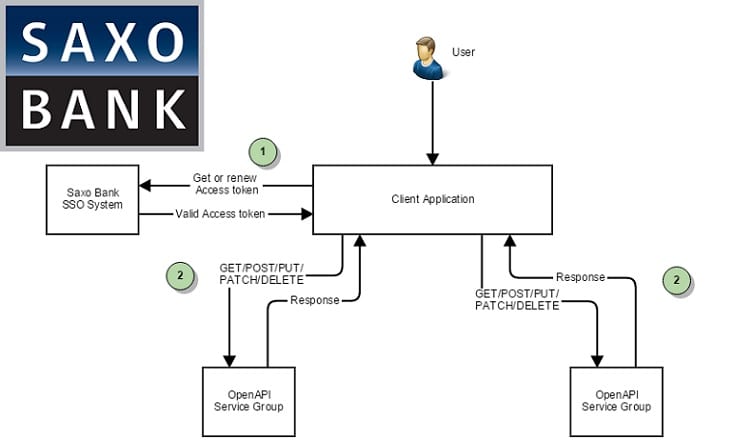Multi-asset broker Saxo Bank has announced the release of its new developer portal.
The portal provides technical documentation, reference guides, sample code and interactive tools for many of the technologies which in combination underpin Saxo’s Open Banking initiative. Saxo’s Open Banking strategy is built on the premise that going forward an increasingly broader range of partnerships and collaborations will be the new disruptive factor in the financial industry. As part of this vision, Saxo has made its multi-asset trading infrastructure available to a wide ecosystem of third-party developers, fintechs, vendors and partners, enabling them to connect their enterprises directly to Saxo’s complete trading engine.

Benny Boye Johansen, Saxo Bank
Benny Boye Johansen, Head of Open API comments:
Open Banking has become a buzz word in the financial industry, but Saxo Bank’s multi-asset trading infrastructure is unique in actually making it possible to tap into almost any part of the value chain using a combination of APIs and technologies. Partnerships and collaboration are key to Saxo Bank’s business model as a facilitator, so we wanted the new portal to be a natural resource for developers no matter what case they were trying to fulfil.
Sometimes all requirements can be realized by a single API. For example, it is possible to write and integrate a complete trading platform via the SaxoOpenAPI, and if you are just looking for best in class liquidity and execution services, it is all available through our FIX technology. You may even combine the two technologies and use our FIX connectivity liquidity provision while at the same time use OpenAPI to source balance and margin information into your proprietary application or directly into Microsoft Excel.
At other times the full palette of technologies comes into play. A Saxo Bank White Label may use our Client Management Services API to create fund and manage their clients in our cloud. They may use our Trade Event Notification System to keep their systems in sync with client trading activity, and Saxo’s comprehensive list of End-of-Day files for all internal bookkeeping and reporting. Additionally they can use SaxoOpenAPI to integrate trading directly into their web portal or to develop a completely bespoke user front-end either complementing or completely replacing our award winning SaxoTraderGO trading platform.
The release of the new developer portal also brings significant improvements to Saxo Bank’s Open API offering. The documentation and the developer tools have been improved and more APIs have been added. This is in line with the strategy to gradually share new functionality on an ongoing basis as it is being made available and used by Saxo’s own trading platforms.
LeapRate spoke with Mr. Johansen about what open banking is, here is what he had to say:
What is Open Banking and why now?
Technological innovation has marked an irreversible shift in consumer expectations and the banking sector is no exception. At Saxo Bank, we believe the answer lies in OpenBanking, whereby the creation of value will come less from owning and more from sharing, providing, and leveraging core assets. Our strategy is to make our internal banking services available to a wide ecosystem of customers, employees, third-party developers, fintechs, vendors and partners. This model resonates with the current strategic priorities of CEOs – growing revenues; reducing cost and complexity; and attracting new employee talent to banking in an age of digital transformation.
What is Saxo’s OpenBanking solution?
Saxo’s OpenBanking solution is a ‘Business as a Service’ in the Cloud, delivered via our OpenAPI and enabling our partners to connect their users to the global capital markets. The model enables firms to connect their enterprises directly to Saxo’s infrastructure and provides access to direct connectivity options such as REST-based OpenAPI, Client Management System API, Introducing Broker client-onboarding API, FIX trading API, Event Notification System API, End-of-Day files drop service and STP Broker Backflow and Drop Copy for 3rd party execution and custodian integration.
Why should financial service firms consider Open Banking now?
API-enabled businesses, such as Saxo and its OpenBanking solutions, have emerged as the most adaptable way for a firm to extract more value out of its client database. This is achieved by adding complete business verticals (offerings) to extend current services within its existing user interface.
Which firms are using OpenBanking and the OpenAPI?
Saxo’s OpenAPI solution is particularly relevant to banks and brokers operating within the capital markets. There is also the potential for niche applications of the solution for wealth managers, emerging start-up financial services firms, financial software companies and financial media companies covering capital markets products and services.
What does Saxo Bank provide to Open Banking clients?
Clients are provided with a developer’s portal, tool-kit resources and sandbox set-ups to ensure that building customized user interfaces on top of Saxo infrastructure is straightforward and simple. Also enabled is aggregated access to more than 36 stock exchanges around the globe, allowing trading in stocks, stock options, ETFs/ETCs and CFDs and 22 global future exchanges for both futures and contract options from the same user account. Clients can bypass the build-versus-buy issue and implement tailored services according to the specific requirements of their users. Access to Saxo’s entire service offering is provided, including services in trading, custody, IT/hosting, integration, retail accounting, reporting risk management and back-office.
What successes has OpenAPI achieved thus far?
Saxo’s OpenAPI project has already extracted direct revenue for clients by enabling them to turn existing aspects of their businesses (which historically have been cost centres) into new revenue centres which are available for sale as a BaaS solution. Further, its application has transcended the financial services industry, Saxo’s traditional sector, and is now servicing new user cases related to the facilitation of capital market services in other sectors such as education, news, and big data analytics.
